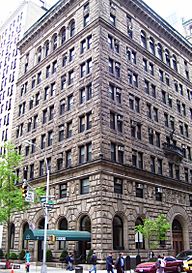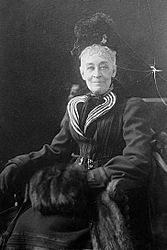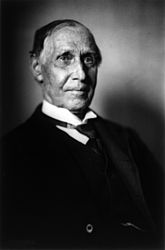Russell Sage Foundation facts for kids
 |
|
| Founded | 1907 |
|---|---|
| Founder | Margaret Olivia Slocum Sage |
| Type | Private Foundation |
| Location |
|
|
Key people
|
President – Sheldon Danziger |
|
Revenue (2016)
|
$15,246,065 |
| Expenses (2016) | $14,187,024 |
| Endowment | $275 million (2015) |
The Russell Sage Foundation is a special American non-profit group. It was started in 1907 by Margaret Olivia Sage. Her goal was to make "social and living conditions in the United States" better. The foundation is named after her husband, Russell Sage, who had recently passed away.
This foundation works to improve how we study and understand problems in society. They use social sciences, which are studies about how people live and interact. The foundation helps researchers and publishes books and a journal. They also support new social scientists. Their main focus areas include jobs, immigration, how different groups live together, and fairness in society. They also study how people make economic choices.
Contents
History of the Foundation
The Russell Sage Foundation began in 1907. It received $10 million from Margaret Olivia Slocum Sage. She was the wife of a very rich railroad owner, Russell Sage. Mrs. Sage wanted the foundation to do many things. These included research, publishing, and helping charities. She also wanted it to support existing helpful groups.
Early Years and Big Changes
When it first started, the Foundation helped people who were poor or elderly. It also worked to make hospitals and prisons better. They helped social work become a new and important job. The Foundation also supported early changes in health care and city planning. They helped with rules about borrowing money and workers' rights. They also supported training for nurses and early social security programs.
In 1907, the foundation helped fund the Pittsburgh Survey. This was the first big study of how working-class people lived in a large U.S. city. The findings helped improve working conditions. For example, steel workers no longer had to work 12-hour days or 7-day weeks. During this time, the foundation supported many important female researchers. These included Mary van Kleeck and Lilian Brandt.
Between 1909 and 1922, the Foundation spent a lot of money. They built Forest Hills Gardens in Queens, New York. This was a model community for working families. The idea was to show that a well-planned neighborhood could work well. At first, homes were affordable. But as New York City grew, prices went up. Soon, the homes became too expensive for the families they were meant for.
In 1922, the Foundation helped start the Regional Plan Association. This group planned how the New York area would grow. The Foundation spent over $1 million on this plan. Researchers wrote 12 large books about it. They believed that growth needed to be managed. This would help businesses and keep New York important.
The Foundation also supported social reformers like Mary van Kleeck. She led the Foundation's Department of Industrial Studies for 40 years. Her work made her believe strongly in social justice.
From 1945 to 1980
After World War II, the Foundation focused on social sciences. They wanted to use these studies to make better decisions for society. They created programs to connect social scientists with leaders. These leaders included lawmakers and health care workers. They also funded research on "social indicators." These are facts and figures that measure how good life is for people.
In the 1950s, the Foundation supported research on charity work. They started the Foundation Center. This group collects information about organized charity. They also published The Foundation Directory. This book lists thousands of large foundations. The Ford Foundation also gave them money to study how social sciences could be used in real life.
In the 1960s and 1970s, the Foundation looked at medical ethics. This included patients' rights. They also studied difficult choices about keeping people alive with new technology. And they looked at using people in research studies.
From 1980s to Today
The Foundation was important in starting behavioral economics. This field combines ideas from psychology with economics. They began a program in 1986 with the Alfred P. Sloan Foundation. They published books like Quasi Rational Economics (1991).
In 1993, they started the Behavioral Economics Roundtable. This group helps advance the field. Three members of this group later won the Nobel Prize in economics. These were George Akerlof, Daniel Kahneman, and Thomas Schelling.
The Foundation also started new programs. These studied immigration, growing economic differences, and how different cultures interact in America. They worked with the Ford Foundation on a study about inequality in cities. In 2000, they partnered with the Population Reference Bureau. They produced a book called The American People: Census 2000.
From 2014 to 2016, the Foundation worked with other groups. They studied topics related to their main interests. These partners included the Carnegie Corporation and the Robert Wood Johnson Foundation. In 2015, the Foundation launched RSF: The Russell Sage Foundation Journal of the Social Sciences. This is a journal where social science research is reviewed by experts and available for free.
What the Foundation Does Now
Research Programs
The Foundation supports four main research areas:
- Future of Work: This looks at why jobs are changing. It also studies how these changes affect low-wage jobs in the U.S. and other rich countries.
- Race, Ethnicity, and Immigration: This program studies how the changing mix of people in the U.S. affects society. It looks at communities and ideas about being American. This program started in 2015.
- Social, Political, and Economic Inequality: This focuses on how growing economic differences affect people in the U.S. It pays special attention to how politics and education respond to these differences.
- Behavioral Economics: This combines ideas from psychology and other social sciences. It helps us understand how people make economic choices.
The Foundation also supports special projects. These include studies on the Affordable Care Act, computational social science, and decision-making. They also look at immigration and how immigrants fit in. They support combining biology and social science knowledge. They also study non-standard work and hold a conference for new behavioral economists.
Books and Journals
The Foundation publishes many books. These books often relate to their research programs. Some important recent books include Homeward: Life in the Year After Prison by Bruce Western. Another is The Long Shadow: Family Background, Disadvantaged Urban Youth, and the Transition to Adulthood. They also published The Asian American Achievement Paradox and Unequal Time: Gender, Class, and Family in Employment Schedules.
The Foundation also publishes RSF: The Russell Sage Foundation Journal of the Social Sciences. This is a journal where experts review social science research. It is available for everyone to read.
They also publish the American Sociological Association’s Rose Series in Sociology. Their books are sent out by the Chicago Distribution Center.
Visiting Scholars and Journalists
The Russell Sage Foundation has a center for Visiting Scholars. These are researchers who come to work on their projects. Each year, they invite scholars to their New York City office. These scholars study topics in social and behavioral sciences. The Foundation especially likes groups of scholars who want to work together.
In 2015, the Foundation started a Visiting Journalists program. This helps journalists do their own research on social, economic, and political issues in the U.S.
They also created the Margaret Olivia Sage Scholars program in 2015. This allows important social scientists to spend time at the Foundation.
Sometimes, the Foundation also offers short-term fellowships. These are for scholars doing research related to the Foundation's main interests.
Robert K. Merton Scholar
- In 1990, Robert K. Merton became the first Foundation Scholar. This honored his long help and guidance.
- In 2000, Nobel winner Robert M. Solow became the second Foundation Scholar. This was after Merton retired. In 2003, the position was renamed the Merton Scholar to honor him.
Archives
The Foundation's old records are kept at the Rockefeller Archive Center. This is in Sleepy Hollow, New York.

Foundation Buildings
Former Gramercy Location
When the Foundation started, they wanted offices in the United Charities Building. But it was full. So, they used several places nearby. In 1912, Margaret Sage and Robert W. DeForest decided to build a main office. It would also be a memorial to her husband. They hired architect Grosvenor Atterbury. He had designed the Forest Hills Gardens project for them. They bought land at 120 East 22nd Street and Lexington Avenue. This was near other important buildings.
The building was built between 1912 and 1913. It was nine stories tall, and a top floor was added later. An extension was built between 1930 and 1931. Atterbury designed the building to look like a grand Italian palace. Because it was a memorial, it was built with expensive materials. For example, the elevators had rare sandstone. In 1922-1923, sculptures were added. They showed the Foundation's goals and work.
The Foundation let other social service groups use space in the building for free. These included the Family Welfare Association of America. They also rented out space in the extension. The New York School of Social Work was a main renter there.
The Foundation sold the building in 1949. It was sold again in 1975 and turned into apartments. It is now called Sage House. The building became a New York City landmark in 2000.
Current Location
Since 1981, the Foundation has been in a building at 112 East 64th Street. This building was designed by Philip Johnson. It was built in 1958-1960 for the Asia Society and Japan Society. The building is in the Upper East Side Historic District.





